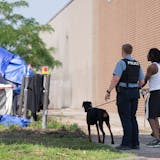With pressure on commercial property owners to "green up" their outdoor landscapes coming from local governments and environmentally conscious tenants, some of them are discovering that saving a distressed mature tree — while not cheap — can be good for both the soul and the bottom line.
While there isn't much argument about their benefits to a commercial property, the trees aren't feeling the love back, arborists and landscape architects say. That's because typical soil conditions around apartment buildings, office campuses and suburban malls are too poor to promote healthy growth, and property owners often seem unwilling to spend upfront to condition their soils properly.
This often results in desperate calls to arborists such as Bartlett Tree Experts to rescue valuable dying trees. To answer the demand, Stamford, Conn.-based Bartlett, which has local offices in Plymouth and West St. Paul, is expanding its services for commercial properties by touting a proprietary "root invigoration" system that uses a supersonic air tool to loosen compacted urban soils around trees.
"After we do a soil analysis, we can use the air tiller to quickly fluff up the soil all the way out to a tree's drip line [the ring on ground level that receives most of the rainwater shed from the tree canopy]," Heaton said. "This allows water and nutrients to reach a tree's feeder roots."
Hoping to get more landscape architects, academic researchers and government forestry officials interested in this so-called Root-Rx process, Bartlett staged a demonstration this week at Como Park Zoo in St. Paul, where zoo officials are hoping to rescue a high-profile bur oak at the entrance of its new, $11 million gorilla forest exhibit.
Arborist Jonathan Heaton and Tom Smiley, a Bartlett arboriculture researcher and adjunct professor at Clemson University, explained to the gathering that workers using a type of "air spade" originally developed to search for land mines can break up compacted soil far more efficiently than previous methods such as drilling holes, all without disturbing a tree's delicate root system.
The next step is to mix in fertilizer, mycorrhizal fungus spores and an organic matter developed by Bartlett known as biochar. This material is derived from biomass such as wood chips, crop residues and manures processed with heat in a low- or no-oxygen environment to produce a carbon-enriched charcoal that promotes microbial activity.
After that's completed, the area around the struggling tree is covered with mulch. The results, Smiley says, are dramatic, with some tree canopies recovering their leaf foliage after just one or two years.

